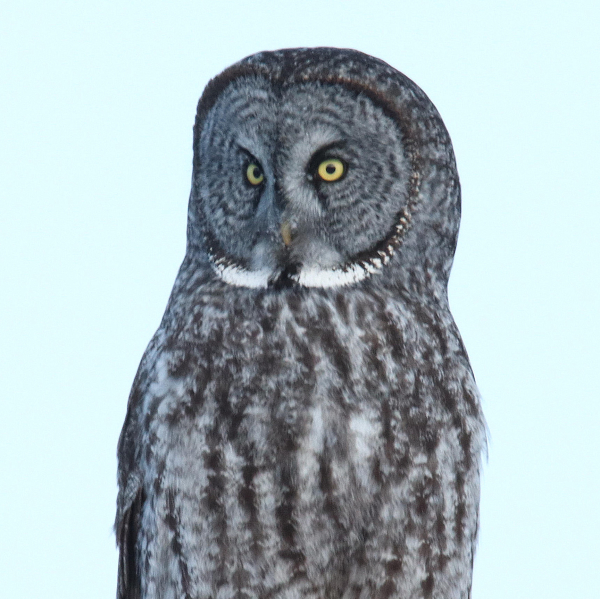
While this is one of the best Great Gray Owl portraits, you can refer to more photos and the story about the post-sunset activities that transpired at the Sax-Zim Bog in the Bird Photography feature in this issue.
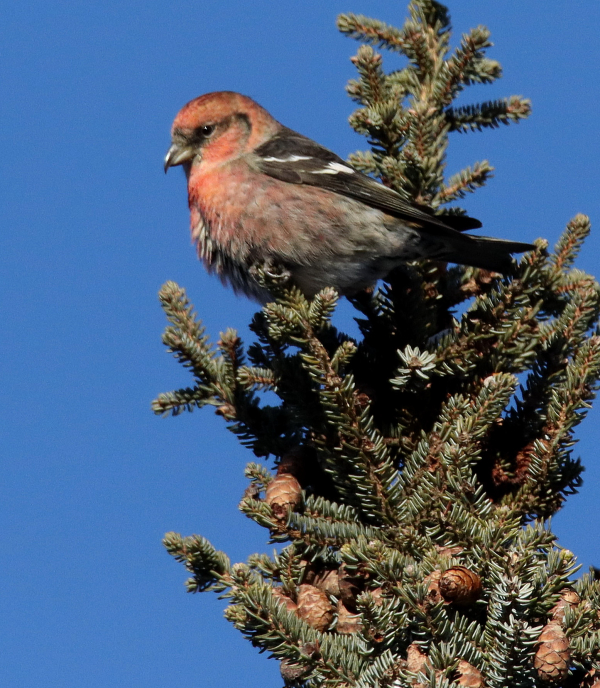
The potential of observing and photographing White-winged Crossbills was at first fleeting, but eventually fruitful as many small flocks were encountered across The Bog in northeast Minnesota.
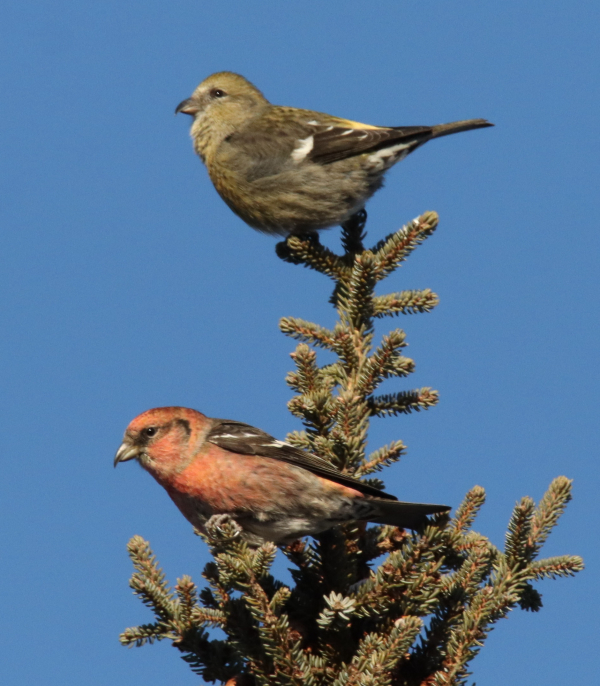
A female and male provide a comparison between White-winged Crossbill sexes while providing a favorite winter photograph in the process. These birds reacted to pishing, with the female singing in response.
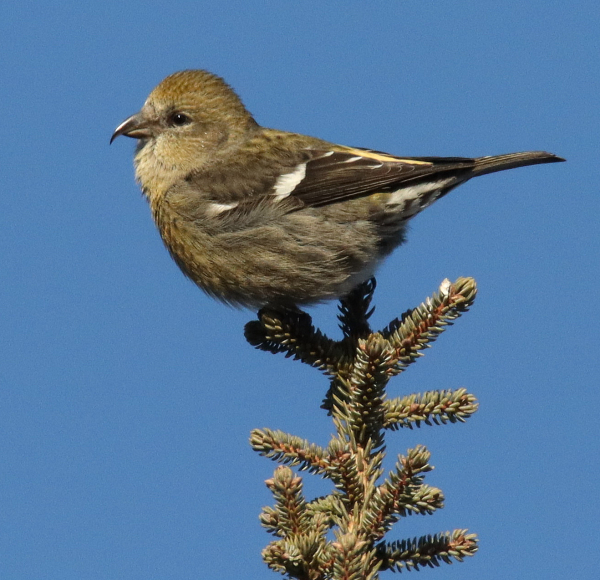
This image provides the most detail of the female as she sang at the top of a black spruce tree. Not normally present in the Bog, this irruption year White-winged Crossbills are plentiful in the Bog area.
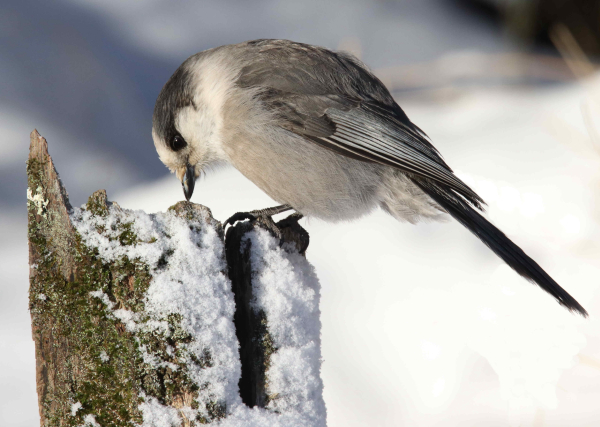
Canada Jays were regular visitors to one of the feeding stations accessible along Bog roadways, while Blue Jays were common at another feeding station that attracted a variety of birds.
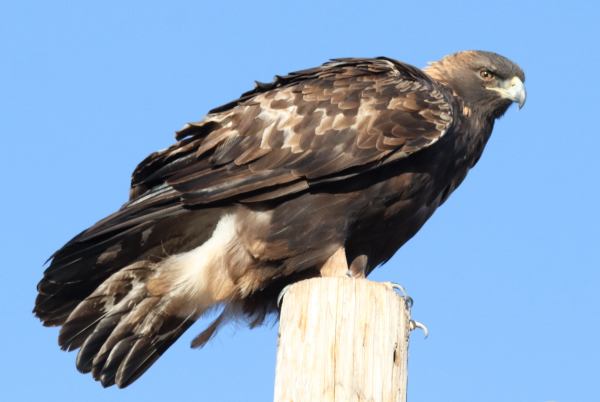
Switching to the South Dakota raptor drive, it was a rewarding experience to spend extra time in close association with an adult Golden Eagle, 1 among the 29 birds of prey sighted the day after Christmas.
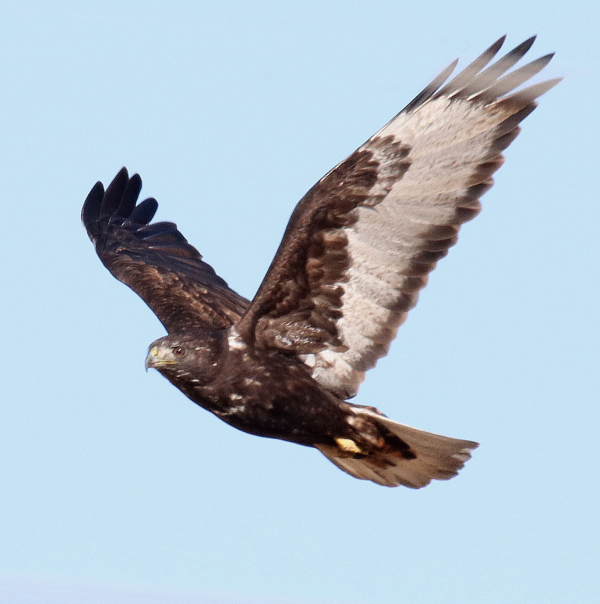
Half of the Red-tailed Hawks observed in SoDak were Harlan’s Red-tails, including this dark morph Harlan’s that has returned to the same winter territory for a number of years.
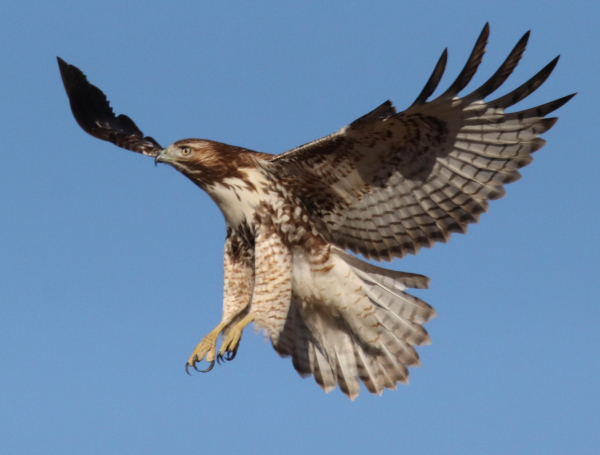
Compare the wing markings between this first-year Red-tailed Hawk and the Harlan’s Red-tail above, among many other plumage variations.
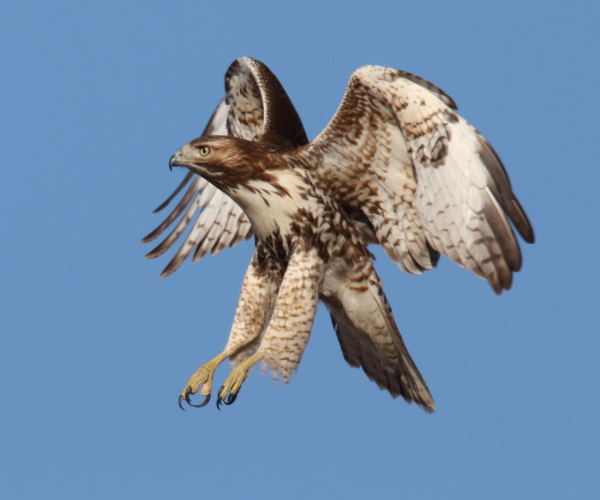
The 2 photos of the young Red-tailed Hawk were taken as it was landing, showing some interesting wing action in the process.
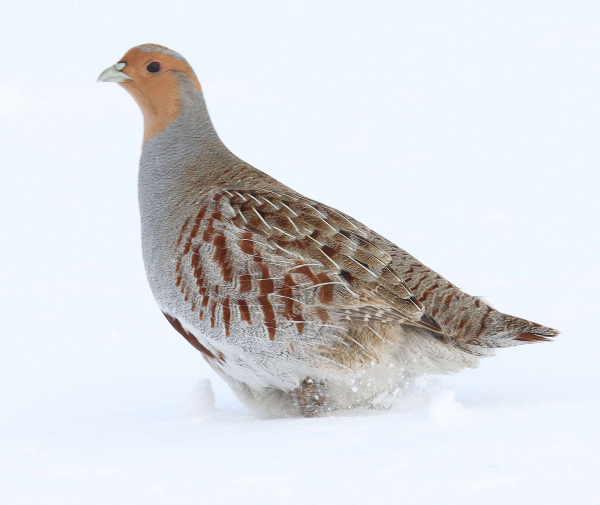
In North Dakota, a partridge in the snow overrides a partridge in a pear tree during the holidays.
|
During the holidays a couple exciting field trips provided a variety of interesting birds to search for, study, and photograph – classic species that would thrill anyone, like a Great Gray Owl, White-winged Crossbills, Canada Jays, Golden Eagles, Harlan’s Red-tailed Hawks, Gray Partridges, a Snowy Owl, and many more. I was following the sun, in spite of the rarity of sunny day weather forecasts, but luck was with me: First at a winter birding mecca, the Sax-Zim Bog in northeast Minnesota, then along my winter raptor survey route centered near Pierre, South Dakota.
While the chance of finding a Great Gray Owl loomed large for the Sax-Zim Bog trip, it was really the potential to photograph White-winged Crossbills and learn more about what makes these birds tick that pressed me far east of home. The story was that there were unprecedented numbers of White-winged Crossbills in the Northwoods – hundreds – so I didn’t want to miss the opportunities they might present; plus I was overdue for a trip to the winter forests of northeast Minnesota. The problem was that no sunny days were forecast during the 2 holiday weeks. Even so, on my first day of holiday vacay, I checked the forecast and Friday was going to be sunny all day in the Bog! The catch was that a fast-moving snowstorm would be blowing through the day before – when I needed to drive 6 hours from home to the Bog – hmm.
I threw caution to the stormy wind, checked my safety equipment and added a big shovel and snow pants, and about 2pm decided I could follow the storm, remaining 2 hours behind it. That worked for the first half of the drive where the rural highway had been well cared for during and after the snowfall, but an hour into Minnesota I accidentally caught up with the storm, which covered the entire road with new snow. As a result, I couldn’t see any lines to show the middle of the highway or the extent of the pavement on the shoulder side, and it was still snowing big flakes. I kept on course, but reduced my speed from 60mph to 40, and that made a big difference in the safety category, but considerably increased the time it would take to drive to the edge of Virginia, Minnesota, a few miles north of the Bog.
After 9 hours behind the wheel, I slept well a few hours, but made it to the Bog just before sunrise, headed for the location I’ve found Great Gray Owls most often. And would you believe that while still a half-mile away I could see the silhouette of one of the big owls perched on a tall snag between me and the rising sun. It was a classic beginning to the exceptional day of birding, and when the owl vanished for the morning I vowed to return before sunset with the hope of finding it with the benefit of afternoon light for possible photographs.
As prime morning sunlight advanced I began an initial drive to check on the feeder action. Local people and the Friends of the Bog maintain several feeding stations that provide birders with close looks at local and wintering seed- and suet-eating birds, including Gray Jays, Blue Jays, Purple Finches, Redpolls, Pine Siskins, American Goldfinches, Black-capped Chickadees, Red-breasted Nuthatches, White-breasted Nuthatches, Downy Woodpeckers, Hairy Woodpeckers, Wild Turkeys, and reportedly Evening Grosbeaks, although I didn’t see any grosbeaks during this visit. Other years Pine Grosbeaks, Boreal Chickadees, Bohemian Waxwings, Cedar Waxwings, and an occasional Northern Cardinal can be found, and some may show up during future weeks.
At one point as I was driving from one feeding station to another, I sighted a small flock of White-winged Crossbills flying across an opening high in the forest – a good sign for future interactions. Next I saw a few White-wings that joined some Redpolls foraging on the snowy road – good to see them low too. I tried to photograph a few times but found it to be a pretty tough task trying to get a close photo of crossbills on the ground, or a clear photo of the crossbills among tree branches. By noon, I prepared myself for the potential that I might not get a good photo of the crossbills, but I was seeing small flocks regularly, so there was still good potential.
During prime afternoon photo time, 2pm, I found an area of black spruce on the north side of a road where a couple small flocks of crossbills were active. That’s when I remembered the birding update on the Bog website suggested “pishing” to attract the crossbills. That sounded too easy, but I gave it a try, and White-wings immediately reacted, flying to perch atop some of the spruces closest to me in full sunlight! I immediately began photographing, focusing on adult males, females, and young males. One female reacted in an especially intent way, calling incessantly and attracting other crossbills so I could fit as many as 4 in a single photo frame – what fun, and I really enjoyed their winter songs!
I was thoroughly impressed with the crossbills’ response to pishing, to the point that I tested its effect by pishing as a male was flying northeast. It immediately reacted by turning 180 degrees in flight to perch atop a nearby black spruce – ha! Pishing opened a whole new world to photographing White-winged Crossbills, so give it a try if you are in their company to get closer views. During the afternoon I also managed 3 sightings of Ruffed Grouse (4 birds), but only managed a couple documentary photos.
By 4pm the sun was low and I returned to check on the Great Gray Owl. There was no sign of an owl during 2 drive-bys, so I checked another location where birders saw a Great Gray that morning, but only found a couple Common Ravens – classic birds of the Northwoods nonetheless. The sun already set by the time I decided I should take a last look for the Great Gray Owl before beginning my return drive toward Dakota. Sure enough, what was probably the same owl was perched in the same area, but there was precious little light to photograph by that time – or so I thought. For the rest of the story, please refer to my Bird Photography feature in this issue, because it turned out that the best owl photo action happened after sunset!
SoDak Raptors
Like the weather forecasts for the Bog, the weather forecasters offered no sunny days in the Pierre, South Dakota area over the holiday period, where I enjoy monitoring wintering birds of prey north and south of the capitol city. However, on Christmas Day the updated forecast showed a full day of sunshine the following day, so I cleared my agenda to hit the road again before sunrise, heading south 3 weeks after my first SoDak winter raptor survey. After a frigid period the previous weekend, the sun provided a 50 degree afternoon across the snowless SoDak landscape and a day filled with photo opportunities.
Before leaving the snow zone to the north, which was covered with a thick layer of frost during early morning, I didn’t see any raptors, but there were 4 widely spaced Northern Shrikes. It has been a bumper period for Northern Shrike sightings across southeast North Dakota so far this winter. To the south, it was a very successful day in the field, even though total raptors and the variety of species were both significantly reduced from the survey I did 20 days before. Even so, the quality of observations and photo opportunities were much better – and that made it an exceptional day.
There were more Golden Eagles, as expected as winter progresses, and 2 provided some fine photographs, the first as it flew toward me, and the last Golden as it perched on a low pole next to a very rural road – a favored pole Golden Eagles use each winter. This eagle not only permitted a fairly close approach without a flinch, but I took advantage of the opportunity to spend an extended amount of time in the eagle’s company. There is something very special about being close enough to look eye to eye with an eagle and study its actions and interests during the period.
Even so, the eagle was watching for movements of potential prey, merely looking from side to side, before and behind it, taking in a wide view of the surrounding area with true eagle eyes. This large Golden Eagle was an adult female, indicated by its large size and large feet – a typical indicator of sex differences among most raptors. I would bet this eagle and I have spent time together before in this area, within a few miles if not at this same pole.
Other exciting observations were among the Harlan’s Red-tailed Hawks, which made up half of the Red-tail count and were composed of 4 dark morph and 1 light morph Harlan’s. At least 2 of the Harlan’s are returning individuals that occupy the same square mile or less each winter – 1 dark morph, and the light morph Harlan’s that has been returning to the same location for several winters. It’s interesting to note that during both of this season’s surveys, all the Red-tailed Hawks were found south of a point beginning 20 miles north of Pierre, while all but 1 of the Rough-legged Hawks have been sighted north of that point.
Now for the totals: There were 6 raptor species sighted (down from 10), including 5 Rough-legged Hawks, 10 Red-tailed Hawks including the 5 Harlan’s Redtails, 6 Golden Eagles (all adults), 4 Bald Eagles (all adults), 3 Northern Harriers, and 1 Merlin for a total of 29 raptors (down from 42). But as noted before, it was an exceptional day, and I suspect the reason for relatively low numbers of raptors was the lack of snow, which tends to concentrate prey and raptors along my route. Few other birds were observed aside from Ring-necked Pheasants and Western Meadowlarks, with both species too abundant to want to try to count.
Local Observations
It’s that time of the year in my area when every bird counts – even the Snow Buntings have vacated – but the birds on hand are exciting birds that not everyone gets to see during a given year. Rough-legged Hawks have topped the list of nearly daily birding outings with between 3 and 0 sighted; Ring-necked Pheasants are sometimes observed in small numbers, usually 1 or 2, and Sharp-tailed Grouse can be seen as solo birds or in flocks numbering up to 16. Ten days ago I observed a Great Horned Owl too, a species that has been unusually rare in the region this fall and winter.
Speaking of rare owl sightings, as I drove home after spending Christmas Eve with my family, I was amazed to see a Snowy Owl fly low into the viewing area illuminated by my car’s headlights, winging to a point above and before me to turn into the south wind, making the big white owl hang a moment directly above the car and allowing me to look up to ascertain it was a first-year Snowy by the abundance of dark markings on the plumage of its underside. This West Fargo surprise was my first sighting of the species in nearly 2 years, making it exceptionally rewarding. Some winters I have seen as many as 87 Snowy Owls, but the past 2 years have been poor years for seeing Snowys south of their Arctic range in the Great Plains.
Earlier that day, I checked my Gray Partridge hotspot where I observed 3 flocks of 12, 7, and 12 for a total of 29 partridges. And not far away I found a hovering Rough-legged Hawk, which I followed about a mile as it hunted at a number of locations along a flight line on the southern edge of Fargo, actually using the updrafts created by buildings to hover and hunt on the wing (the buildings included a school, a couple businesses, and a 2-story apartment building). That behavior was quite different from any Rough-legs I’ve seen before – they usually aren’t found near towns or cities, but I’ve seen 3 on the edges of Fargo recently.
At home, my first-ever wintering Harris’s Sparrow has been a regular visitor at my platform feeder, while it and Dark-eyed Juncos forage below the feeders too, including 2 juncos that are colored to show they belong to the western Oregon subspecies. The primary group of feeder visitors are White-breasted Nuthatches and House Finches, with occasional visits by a male Hairy Woodpecker. But I’m sorry to report that the Blue Jays vacated the area en masse (all 4 of them), sometime the weekend between Christmas and New Year’s – darn, they will be missed.
But wait, last Friday afternoon a lone Blue Jay came to my platform feeder, and returned the following day. Then Sunday, at least 3 Blue Jays mobbed my platform feeder repeatedly, which continued Monday. I did have a second male Hairy Woodpecker stop by for suet Monday afternoon too. But Tuesday as I put the finishing touches on this issue, all has been quiet as far as jays go.
I truly expected to see more wintering species arrive by now, but I’ll let you know when new birds find my hideaway. I hope your holiday season was fun, rewarding, and filled with family, friends, and neighbors with some free time for birding. Considering last year, and even the past month, I’m expecting another exciting year of bird observations and photo opportunities, changing and improving as months progress, and my wish for all of you is a prosperous year filled with lots of interesting birds and birding experiences.
Article and Photos by Paul Konrad
Share your bird sightings and photographs at editorstbw2@gmail.com